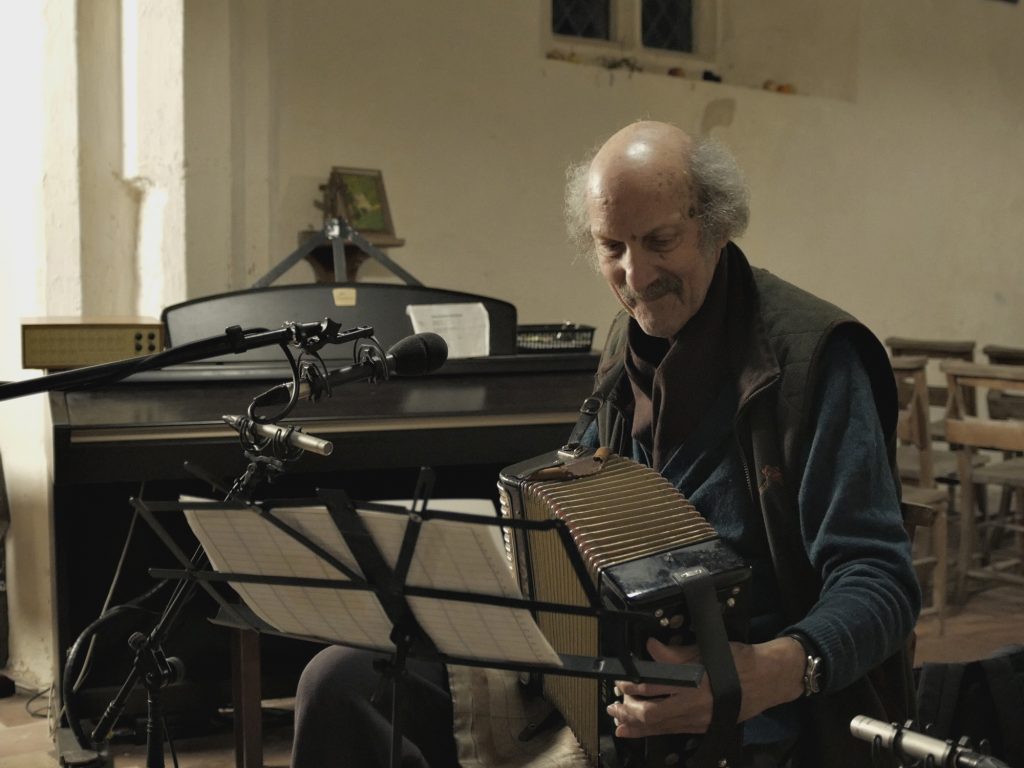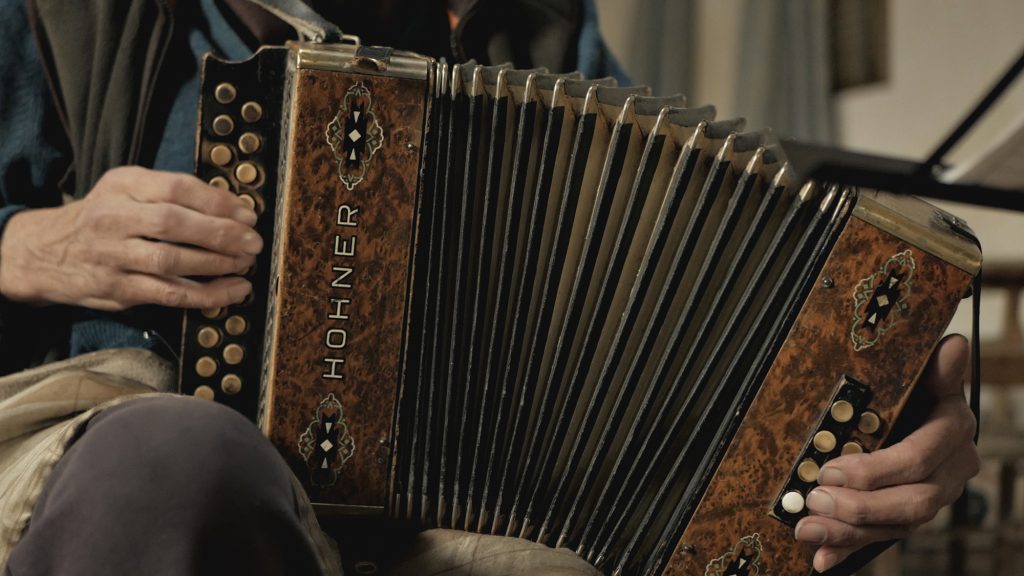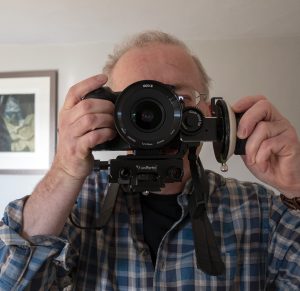
Tony Hall’s melodeon playing has long been much revered in the world of folk music, and can be heard on Maddy Prior and June Tabor’s ‘Silly Sisters’ album, on Nic Jones’s ‘Penguin Eggs’ album, and on his own recordings: ‘Field Vole Music’ (1977), ‘Mr Universe’ (1995), and ‘One Man Hand’ (2008). Despite his many live performances over the years (not least with the weekly performances of The Vonn Krapp Family Band for around 50 years), there are few videos of Tony playing. Given his unique style and, also, his relaxed and humorous stage presence, this is a real pity. A few years ago I set out to rectify this, but Covid intervened and, to be honest, Tony got slightly cold feet about such self-promotion! But patience rewards those who wait, and with the help of a mutual friend (thank you Matt!), a few weeks ago Tony agreed to the recording and filming of a live performance.
Tony’s set followed a harvest supper at his local church so I had no wish to intrude too much on the occasion. A low profile was essential, and there would be little to no time for adjusting gear on the night. With such events, preparation is, of course, very much the order of the day, so in the weeks beforehand I had a sound check with a stand-in melodeon player (thank you Rob!) and a lighting test (the church lighting looked hopeless) one evening.

On the audio side, recording melodeon (and accordion) is challenging since so much sound comes out of the sides and, of course, the left (bass) hand moves in and out. I’ve tried various techniques over the years, and the sound test before this session confirmed my conclusion that the best way is to record with mics positioned either side of the instrument. It’s also how Tony has mics set up whenever he uses a PA, so it was good to have a set up that was comfortable for him too. I’d have preferred omni mics, not least as the acoustic was good, but with an audience liable to sing along or cough, and, even, the potential for a bit of clatter from someone having their third helping of pudding (I wouldn’t blame them as they were marvellous!) I went for cardioid mics, and angled them a bit so the rear nulls had some effect. Mics either side gives a much fuller sound than a stereo pair in front of the melodeon, but, of course, if hard-panned left and right the mics make the instrument sound 30ft wide: after playing around and testing on speakers and headphones in post, I settled on panning 40% left and right. I used a pair of Rode NT55s. For vocals, I wanted as much separation from the melodeon as possible, so that I could vary levels after the event, and would have preferred a large diaphragm condenser (LDC) fig 8 so I could use its null to good effect, but, conscious that this would mean the rear lobe would pick up the audience too much and that it would be far from discreet, went for an SDC hypercardioid – the AKG CK93.
Filming gear needed to be equally discreet. The bad lighting was solved by a single softbox lantern (the SmallRig 65cm version) with a SmallRig 3616, which is a COB LED light that is bi-colour (so I could set colour temperature to match the church lights at 2700K). Lanterns are so much gentler on the performer than a rectangular softbox, and the single light didn’t intrude unduly: as benign as a standard lamp. Cameras were a Lumix G9 and two Lumix GX80s, two cameras roughly at 45 degrees, and one, low down, centrally, to catch Tony’s fingers on the melodeon buttons (so aficionados can see how he does it). All three cameras locked off on tripods, and two unmanned: far from ideal, but nicely low key. With a bit of varied cropping from the 4k capture for the 1080p output, that gave some variety in the shots in the final video. And low-key video suited the occasion anyway.
So the end result? Well judge for yourself, but it certainly captured something of the event, is a step up from the few mobile phone videos of Tony online, and was a reasonable stab given the understandable constraints. And the bonus? Tony is keen to go on and make a proper album in the same church this autumn/winter, without an audience. He doesn’t enjoy the stress of studio recording, or the excessive editing of multiple takes to create the performance that never was, but he’s up for a relaxed recording in his local church, which is great news: Tony still has many a song/tune he would like to record for posterity. Obviously there will be scope for much improving the sound of the audio from the harvest supper gig, so more anon.

 After years of Nikon DSLRs for stills (from D70 to D810) I have recently adopted Micro Four Thirds (M43) for both stills and filmmaking: with close-focus like most in their 50s, a mirrorless camera with electronic viewfinder seemed a wise move, and I was getting sick of lugging a rucksack of full-frame gear up scaffolding ladders to the top of cathedrals and castles for the day job. I already had a couple of M43 bodies (Lumix GX80) and some Panasonic lenses, so added a few more lenses and a Panasonic Lumix G9: in 2020/2021 this is a real bargain, with 10-bit internal recording giving near-GH5-like video, on top of much better stills (not least the 80MP high-resolution mode).
After years of Nikon DSLRs for stills (from D70 to D810) I have recently adopted Micro Four Thirds (M43) for both stills and filmmaking: with close-focus like most in their 50s, a mirrorless camera with electronic viewfinder seemed a wise move, and I was getting sick of lugging a rucksack of full-frame gear up scaffolding ladders to the top of cathedrals and castles for the day job. I already had a couple of M43 bodies (Lumix GX80) and some Panasonic lenses, so added a few more lenses and a Panasonic Lumix G9: in 2020/2021 this is a real bargain, with 10-bit internal recording giving near-GH5-like video, on top of much better stills (not least the 80MP high-resolution mode).


